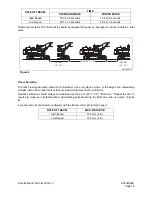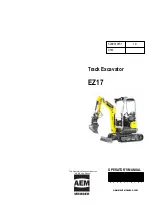
S0302000
Page 5
General Maintenance Procedures
Return to Master Table of Contents
MAINTENANCE SERVICE AND REPAIR PROCEDURE
GENERAL PRECAUTIONS
Fluid level and condition should always be checked whenever any other type of maintenance service or
repair is being performed.
NOTE:
If the unit is being used in an extreme temperature environment (in sub-freezing climates
or in high temperature, high humidity tropical conditions), frequent purging of moisture
condensation from the hydraulic reservoir drain tap should be a regular and frequent part
of the operating routine. In more moderate, temperate climates, draining reservoir
sediment and moisture may not be required more than once or twice every few months.
Inspect drained oil and used filters for signs of abnormal coloring or visible fluid contamination at every oil
change. Abrasive grit or dust particles will cause discoloration and darkening of the fluid. Visible
accumulations of dirt or grit could be an indication that filter elements are overloaded (and will require more
frequent replacement) or that disintegrating bearings or other component failures in the hydraulic circuit
may be imminent or have already occurred. Open the drain plugs on the main pump casings and check
and compare drain oil in the pumps. Look for evidence of grit or metallic particles.
Vibration or unusual noise during operation could be an indication of air leaking into the circuit (Refer to the
appropriate Troubleshooting section for component or unit for procedures.), or it may be evidence of a
defective pump. The gear-type pilot pump could be defective, causing low pilot pressure, or a main pump
broken shoe or piston could be responsible.
NOTE:
If equipped, indicated operating pressure, as shown on the multidisplay digital gauge on
the Instrument Panel ("F-Pump" and "R-Pump") will be reduced as a result of a
mechanical problem inside the pump. However, pressure loss could also be due to
cavitation or air leakage, or other faults in the hydraulic system.
Check the exterior case drain oil in the main pumps. If no metallic particles are found, make sure there is
no air in the system. Unbolt and remove the tank return drain line from the top part of the swing motor, both
travel motors and each main pump. If there is air in any one of the drain lines, carefully pre-fill the
assembly before bolting together the drain line piping connections. Run the system at low rpm.
IMPORTANT
Hydraulic system operating conditions (repetitive cycling, heavy work loads, fluid circulating
under high pressure) make it extremely critical that dust, grit or any other type of contamination
be kept out of the system. Observe fluid and filter change maintenance interval
recommendations and always pre-clean any exterior surface of the system before it is exposed
to air. For example, the reservoir filler cap and neck area, hoses that have to be disassembled,
and the covers and external surfaces of filter canisters should all be cleaned before
disassembly.
Summary of Contents for Solar 300LC-V
Page 2: ......
Page 4: ......
Page 7: ...1SAFETY...
Page 8: ......
Page 46: ...S0102000 Page 38 Track Excavator Safety...
Page 47: ...1SPECIFICATIONS...
Page 48: ......
Page 54: ...S0202080K Page 6 Specifications for Solar 300LC V...
Page 70: ...S0202080K Page 22 Specifications for Solar 300LC V...
Page 71: ...1GENERAL MAINTENANCE...
Page 72: ......
Page 86: ...S0302000 Page 14 General Maintenance Procedures Return to Master Table of Contents...
Page 99: ...1UPPER STRUCTURE...
Page 100: ......
Page 102: ...S0402040K Page 2 Cab TABLE OF CONTENTS Removal 3 Installation 6...
Page 116: ...S0403050K Page 8 Counterweight Return to Master Table of Contents...
Page 140: ...S0407000 Page 6 Swing Bearing...
Page 164: ...S0408070K Page 24 Swing Reduction Gear...
Page 165: ...1LOWER STRUCTURE AND CHASSIS...
Page 166: ......
Page 190: ...S0505000 Page 24 Track Assembly 7 Tighten plug 1 Figure 48 Figure 48...
Page 191: ...S0505000 Page 25 Track Assembly TRACK SPRING AND TRACK ADJUSTING CYLINDER PARTS LIST Figure 49...
Page 193: ...1ENGINE AND DRIVE TRAIN...
Page 194: ......
Page 205: ...S0605060K Page 11 Air Conditioner Face and Defroster ARS1300L Figure 12...
Page 220: ...S0605060K Page 26 Air Conditioner...
Page 229: ...1HYDRAULICS...
Page 230: ......
Page 262: ...S0703010K Page 2 Accumulator TABLE OF CONTENTS General Description 3 Specifications 4...
Page 266: ...S0703010K Page 6 Accumulator...
Page 274: ...S0704080K Page 8 Center Joint Swivel...
Page 283: ...S0705000 Page 9 Cylinders...
Page 287: ...S0705000 Page 13 Cylinders...
Page 291: ...S0705000 Page 17 Cylinders...
Page 299: ...S0705000 Page 25 Cylinders...
Page 308: ...S0705000 Page 34 Cylinders 17 Force out pin bushing 1 from body of cylinder Figure 28...
Page 312: ...S0705000 Page 38 Cylinders...
Page 324: ...S0707270K Page 12 Swing Motor Toshiba MFC200 PARTS LIST Figure 6...
Page 355: ...S0707315K Page 11 Travel Motor with Gearbox...
Page 424: ...S0708315K Page 28 Main Pump Kawasaki CONSTRUCTION OF REGULATOR Figure 22...
Page 444: ...S0708315K Page 48 Main Pump Kawasaki...
Page 450: ...S0709401K Page 6 Main Control Valve Kayaba Figure 1...
Page 451: ...S0709401K Page 7 Main Control Valve Kayaba Figure 2...
Page 453: ...S0709401K Page 9 Main Control Valve Kayaba...
Page 455: ...S0709401K Page 11 Main Control Valve Kayaba Figure 4...
Page 467: ...S0709401K Page 23 Main Control Valve Kayaba Figure 16...
Page 500: ...S0709401K Page 56 Main Control Valve Kayaba Figure 54...
Page 552: ...S0792160K Page 6 Hydraulic Schematic S300LC V...
Page 553: ...1ELECTRICAL SYSTEM...
Page 554: ......
Page 608: ...S0802220K Page 54 Electrical System...
Page 627: ...S0802220K Page 73 Electrical System...
Page 634: ...S0892160K Page 4 Electrical Schematic S300LC V SOLAR 300LC V Figure 2...
Page 636: ...S0892160K Page 6 Electrical Schematic S300LC V...
Page 637: ...1ATTACHMENTS...
Page 638: ......
Page 658: ......






































